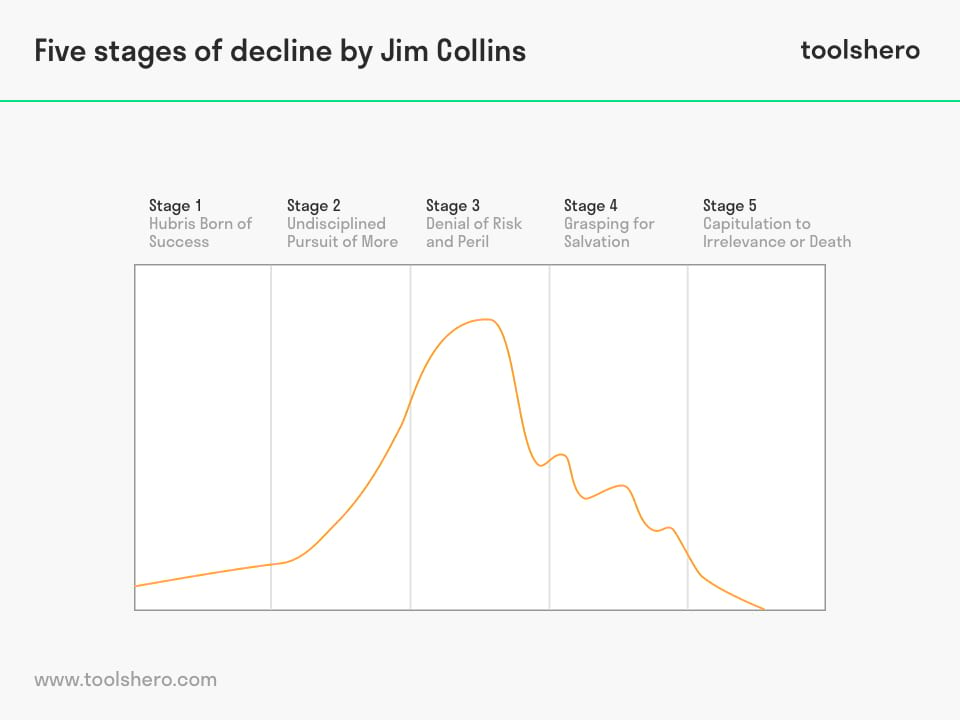Five Stages of Decline by Jim Collins explained

This article explains the five stages of decline described by Jim Collins in a practical way. Next to wtha these stages are (and it’s origin), this article also highlights Organisational decline wheer the five stages practically are explained and a summary. After reading, you’ll understand the basics of this powerful strategic analysis tool. Enjoy reading!
What are the five stages of decline by Jim Collins?
The five stages of decline, described by Jim Collins, also known as the five stages of organisational decline, are a concept from the book How the Mighty Fall. In this book, Jim Collins states that all organisations, no matter how large, are vulnerable to decline. This decline, leading to a company’s eventual downfall, is described as an illness that proceeds in stages. If diagnosed early, this illness can be cured easily.
However, it’s very difficult to detect the disease at an early stage. The later the illness is diagnosed, the harder it is to recover from organisational decline.
Jim Collins created the concept after focusing on eleven companies that were very successful at one point in time, but then staggered and fell. Examples of companies that found themselves in such situations are A&P, Hewlett-Packard, and Motorola. He compared the performances of these organisations to a comparable company from the same industry. For example, he compared Wal-Mart and Ames. They shared the same business model, and had similar revenue. Wal-Mart rocketed up in the 1980s, whereas Ames lost market share.
He discovered it’s much easier for a company to decline than to become big. He developed a framework with five stages that describes the process of decline in many cases. Jim Collins emphasised that the concept is not applicable to all organisations and situations. This is because the model does not include aspects such as fraud, corruption, scandals, or accidents.
Five Stages of Decline: Organisational decline
The five stages of decline described by Jim Collins are summarised below. For each stage, it is explained what situation the organisation is in and how large the chances are that the organisation may yet recover.

Figure 1 – Five stages of decline model
Stage 1: Hubris Born of Success
‘Hubris’ means inordinate pride that can take down a powerhouse, or a scandalous arrogance that damages the innocent. When past performances form the basis for a feeling of invulnerability, and considered a guarantee for future success, hubris has started.
This false sense of safety comes about because people think they can make something out of nothing, as when the company was founded. Another process of hubris is neglecting primary means for the organisations, the forces driving success. The driving force behind an organisation’s success is also known as the flywheel, or competitive advantage.
Another feature of the first phase of the five stages of decline described by Jim Collins is the loss of the adventurous, open-minded, and innovative approach to learning and improving.
Stage 2: Undisciplined Pursuit of More
In this phase of the five stages of decline described by Jim Collins, organisations stray from the structure and activities that led them to greatness in the first place. In the example of Wal-Mart, they kept their focus on small towns and their strategy for low prices, whereas Ames lost focus by buying Zayre department stores.
In this phase, companies strive for growth, but there is no structure and discipline in their business activities. There are also too many tasks and jobs that do not contribute to the core activities. Increasing weight is added to the organisation to make it perform better, but the imbalance leads to the organisation’s decline.
Stage 3: Denial of Risk and Peril
In the third phase, the organisation denies risks and perils, but things continue to look good from the outside. On the inside, however, more and more signs of decline appear. Companies that find themselves in such a situation tend to exaggerate positive things and downplay negative data or performances.
Instead of really taking on problems, in this phase, reasons and excuses are made up to explain why things happen. Those reasons are usually the consequence of the unstructured working method from phase 2, and external influences that were not noticed in time.
Stage 4: Grasping for Salvation
‘Grasping for salvation’, phase four of the five stages of decline described by Jim Collins, suggests the organisation has lost awareness when it comes to its own greatness and competence. Its self-confidence has completely gone away, and change can only be made possible through a series of ‘silver bullets’. Silver bullets are leaps in technology, new solutions to problems, or entering new markets. They are events that can help the organisation get back in the black.
The organisation may also be saved by a charismatic leader with a clear vision, a radical transformation, or a blockbuster.
Stage 5: Capitulation to Irrelevance or Death
In the last phase of the five stages of decline described by Jim Collins, the organisation slowly slides into the abyss, and leaders finally give up their courage and hope. The company is sold, disappears into irrelevance, or shuts down. The board gets tied up in a stalemate of groupthink and fatalism, and eventually decides unanimously to jump ship. In many situations, in the end, it will feel as if that was the best option, because there is a feeling that whatever could be done was done.
To summarise
According to Jim Collins, then, there are five phases in the process of an organisation going under. In the first phase, arrogance and success are decisive aspects. This causes employees and managers to forget what made the organisation succeed in the first place.
Slowly, the organisation starts to believe they can succeed in anything. Although the belief that more can be realised is strong, the organisation goes to work in an undisciplined way. Subsequently, deficits slowly come to the surface.
From the outside, everything may still look good, but the first deficits usually appear on the inside. Positive thoughts and data are magnified, and the negative data or indications are put aside. Eventually, in phase four, the decline is visible and noticeable to all. In this phase, leaders still make instinctive efforts to reverse the decline. In the next phase, it’s too late for that. At that point, there’s no way back. Organisations may recover from phase four, but according to Jim Collins and the five stages of decline, it’s absolutely necessary to avoid this phase, as well as the final one.
Now it’s your turn
What do you think? Do you recognise the explanation about the five stages of decline by Jim Collins? Can you share an example of an organisation in your environment that is in a late stage? What practical lessons can you draw from this theory? Do you have any tips or additional comments?
Share your experience and knowledge in the comments box below.
More information
- Cameron, K. S., Whetten, D. A., & Kim, M. U. (1987). Organizational dysfunctions of decline. Academy of Management journal, 30(1), 126-138.
- Collins, J. C. (2009). How the mighty fall: And why some companies never give in. Random House.
- Gilbertson, D. T., Liu, J., Xue, J. L., Louis, T. A., Solid, C. A., Ebben, J. P., & Collins, A. J. (2005). Projecting the number of patients with end-stage renal disease in the United States to the year 2015. Journal of the American Society of Nephrology, 16(12), 3736-3741.
- Levine, C. H. (1978). Organizational decline and cutback management. Public administration review, 38(4), 316-325.
How to cite this article:
Janse, B. (2019). Five Stages of Decline by Jim Collins explained. Retrieved [insert date] from Toolshero: https://www.toolshero.com/strategy/five-stages-of-decline/
Published on: 09/19/2019 | Last update: 02/07/2023
Add a link to this page on your website:
<a href=”https://www.toolshero.com/strategy/five-stages-of-decline/”>Toolshero: Five Stages of Decline by Jim Collins explained</a>












